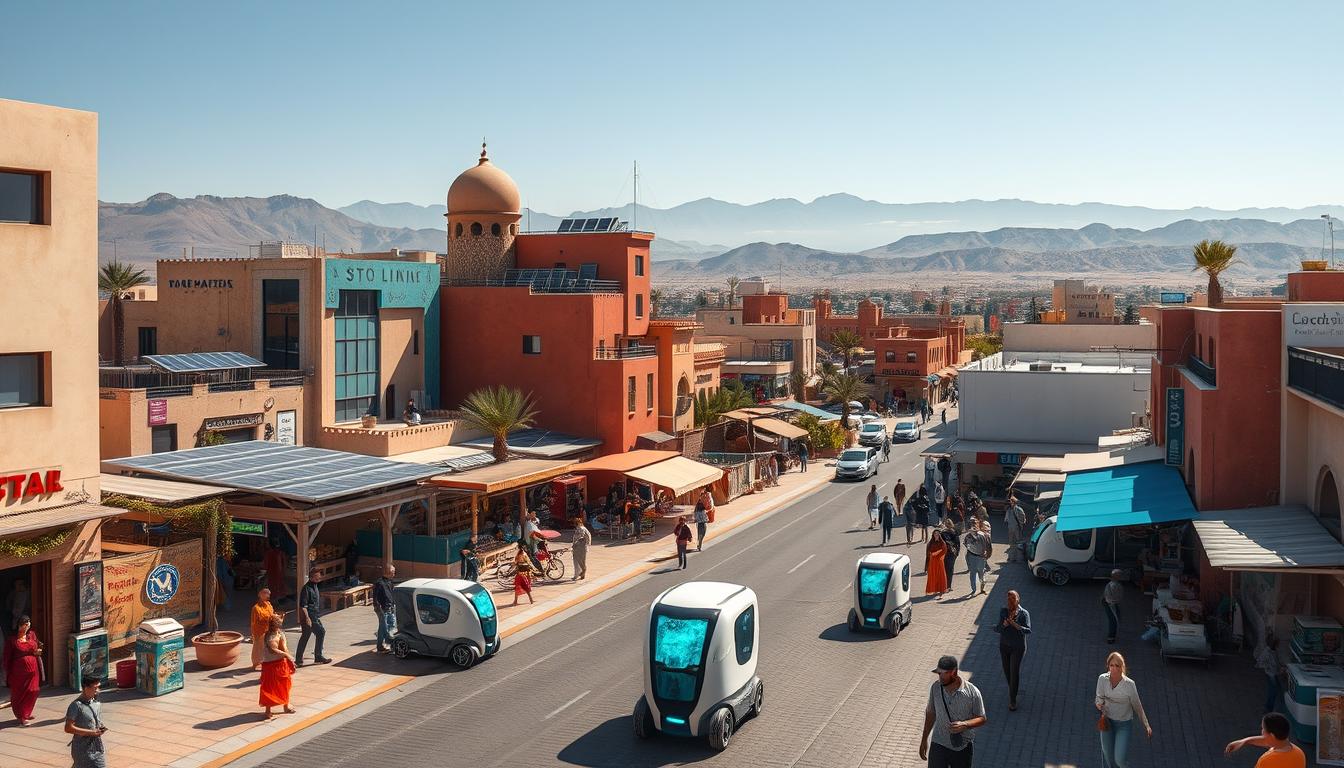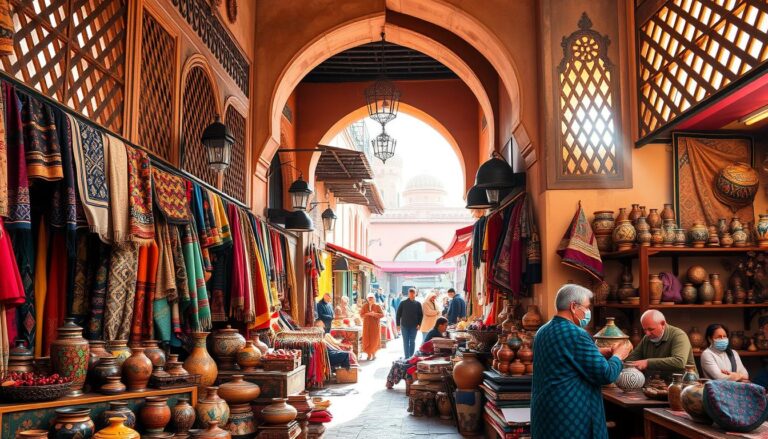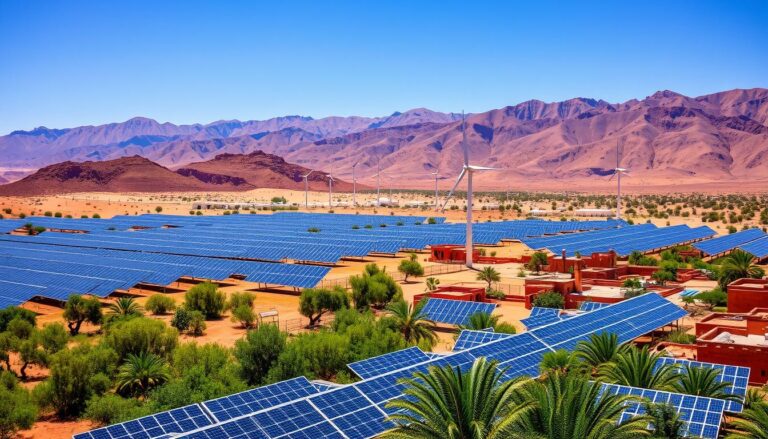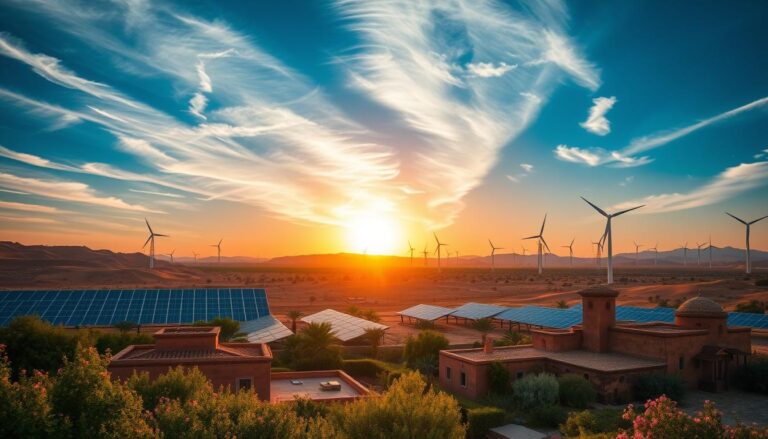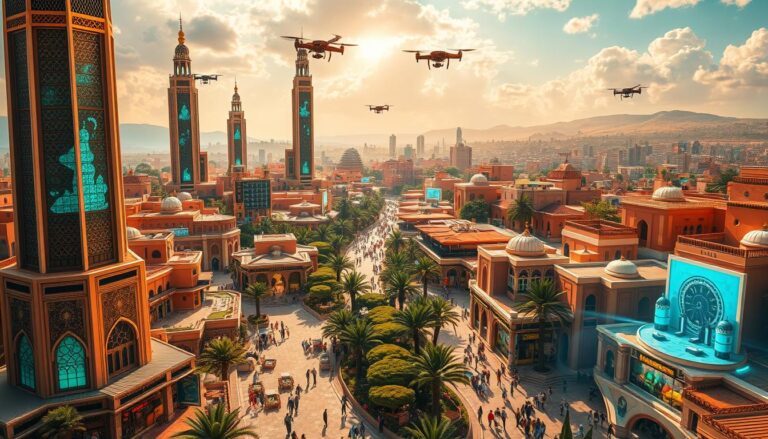Is Morocco set to lead Africa’s digital future with its bold transformation plan?
Morocco sees digital transformation as key to its economic growth. It has started a big change to make its economy better. The National Digital Development Strategy 2020-2025 shows Morocco’s goal to be a top digital economy in Africa by 2030.
With help in digital strategy consulting and building strong technology infrastructure, Morocco is tackling important steps for digital growth.
The Moroccan e-Government Program and the Digital Morocco Plan are key to this change. They help make services online and support small businesses with digital tools. This shows Morocco’s plan for a digital economy that works for everyone.
This isn’t just about tech; it’s about improving life for Moroccans and making the country a digital leader. The government has set goals like making half of public services online by 2020. They aim to fully digitize all government work by 2030.
Introduction to Morocco’s Digital Transformation Efforts
Morocco is working hard to become a digital leader. The government is leading the way with smart plans and investments. They make sure everything is in place for digital growth to last.
Government Initiatives and Policies
The Moroccan government has launched many tech-focused plans:
- e-Morocco 2010 strategy
- Digital Morocco 2013 plan
- Digital Morocco 2020
- Digital in Morocco by Horizon 2025
The Agency for Digital Development (ADD) was set up in 2017. It has created two key platforms for digital mail. These steps are part of Morocco’s goal to be a digital leader in Africa, starting in 2005.
Impact on Socio-Economic Development
The digital change has greatly helped Morocco’s economy and society. The government wants to make public services better. They aim to digitize over 600 services, helping citizens, businesses, and governments.
The plan also aims to boost the economy. It wants to create 240,000 jobs and add 100 billion MAD to the GDP. Digital exports are expected to grow from 17.9 billion MAD in 2023 to 40 billion MAD. The goal is to start 3,000 new businesses and raise 7 billion MAD for them by 2030.
Training young people in digital skills is a big focus. The plan is to teach 100,000 young people every year, up from 14,000 in 2022. This shows the government’s dedication to growing businesses and preparing a skilled workforce for Morocco’s digital future.
The Role of the Digital Development Agency (ADD)
The Digital Development Agency Morocco was set up in 2015. It plays a key role in Morocco’s digital growth. The agency works to improve digital skills, innovation, and the digital environment for everyone.
Main Objectives and Programs
The Digital Development Agency Morocco aims to close the digital gap. It works with telecoms and internet providers to increase digital access. In rural areas, it promotes satellite and wireless tech and expands fiber optic networks.
The agency also helps industries like tourism, agriculture, health, and education go digital. It supports small businesses and startups by creating digital products and helping them go online. Through workshops and training, it boosts digital skills among students, teachers, government workers, and business owners.
National Digital Development Strategy 2020-2025
The National Digital Development Strategy 2020-2025 is Morocco’s digital roadmap. It aims to make Morocco a digital leader by 2030. The strategy focuses on improving digital infrastructure, encouraging innovation, and using advanced tech like AI and Big Data.
The government has pledged 11 billion dirhams to the Digital Morocco 2030 plan. This plan aims to train 100,000 young people in digital fields each year. It also wants to increase digital graduates from Moroccan universities by 2027.
The plan also includes creating 240,000 jobs in the digital sector. It aims to make Morocco a top digital nation in Africa and among the world’s top 50. Working with international partners like the BMZ and DTC Morocco is crucial for Morocco’s digital progress.
Innovative Technology Solutions Driving Change
In Morocco, new tech is leading the way in digital growth. It’s changing how businesses work, making things more efficient and connected. Key players like AI, Big Data, and IoT are leading this change, bringing big benefits to many areas.
Artificial Intelligence and Big Data
AI and Big Data are changing how Moroccan businesses run. Over 50% of companies use data analytics to drive change. AI is key to this, as seen in the SGS network’s use of data for better decisions.
Gartner’s study shows 56% of CEOs see profit boosts with AI and Big Data. These tools help make brands more personal and agile. The goal is to digitize 30% of customer journeys by 2023, showing Big Data and AI’s importance.
Internet of Things (IoT)
The Internet of Things is set to change Morocco’s industry 4.0 by making things more connected. 42% of companies see IoT as crucial, improving infrastructure. IoT devices make processes smoother, help keep clients, and offer personalization.
IoT also brings economic benefits by making workflows more efficient and cheaper. This leads to cost savings and faster processes, making businesses leaner.
Big Data, IoT, and AI are the backbone of Morocco’s industry 4.0. They’re driving big steps forward in the country’s digital growth.
Supporting Small and Medium-Sized Enterprises (SMEs)
In Morocco, SMEs play a big role in the economy. The government knows this and is helping them grow. They offer SME digital transformation support to help them succeed in the competitive global market.
DigiTPME is a key program that gives SMEs the tools they need to modernize digitally. This is crucial for their survival and growth.
For SMEs to grow, they need to get better at using digital tools. This helps them work more efficiently, save money, and connect better with customers. It’s all about digital transformation for business growth.
Investments in digital empowerment have been made to help SMEs. For example, the World Bank Group has backed a project to boost digital technology adoption. This project focuses on improving digital infrastructure for small businesses.
The Doing Business Index shows Morocco is getting better for businesses, especially SMEs. The CPF uses private money and sustainable solutions to help. This support is key for SMEs to succeed in the competitive global market.
Private sector involvement is also important. It helps in areas like infrastructure, education, digital finance, and regional development. This gives SMEs the resources they need to do well.
Digital transformation is not just about growing SMEs. It also helps Morocco’s economy grow. With digital tools and technology, SMEs are ready for the future and global opportunities.
E-Government: Streamlining Public Services
Morocco is moving fast towards digital change, focusing on better public services. E-Government strategies show the country’s dedication to making things easier and faster. This helps both citizens and businesses a lot.
Unified Administrative Services Portal
The Unified Administrative Services Portal is a key part of Morocco’s E-Government plan. It aims to make government interactions clearer and efficient public services more accessible. Morocco wants to cut down on waiting times and paperwork by 2030.
Citizen-Centric Digital Services
Morocco is also working on citizen-centric digital services. These services are designed to meet the needs of its people, aiming for high user satisfaction. Programs like ENNAJAA help improve how the government works and delivers services.
By using digital solutions, Morocco hopes to boost its E-Government Development Index (EGDI) ranking. It also wants to make it easier for people to access public services. This effort is part of a bigger plan to digitize the country.
Digital Transformation Strategy in Morocco
The Digital Transformation Strategy in Morocco focuses on key areas. It aims to digitize services, boost the digital economy, and encourage local innovation. This strategy aims to make Morocco a leader in digital transformation in the region.
Key Pillars and Goals
Morocco has set aside USD 1.1 billion for digital sector growth. The main goals include:
- Training 100,000 young people annually in digital fields, up from 14,000 in 2022.
- Tripling digital graduates in public universities by 2027.
- Employing 240,000 people in the digital sector.
- Creating 130,000 new jobs through sector agreements.
Morocco is committed to becoming a digital hub. It aims to improve in global e-government rankings and stay competitive.
Strategic Partnerships and Investments
The maroc digital 2030 framework also emphasizes strategic digital partnerships and investment in digital transformation. Here are some key initiatives:
“In 2020, the World Bank approved $500 million to support Morocco’s financial and digital inclusion reforms.”
- Oracle’s plan to open a new R&D facility in Morocco in 2022.
- 550 scholarships of 7,000 dirhams per month for three years to support advanced technology research.
- The Agence de Developpement du Digital’s efforts since 2017 to execute digital strategies.
These efforts aim to help Morocco achieve its maroc digital 2030 vision. They are expected to increase digital sector jobs and boost GDP growth.
Educational Initiatives and Human Capital Development
Morocco is making a big push to revalue human capital and speed up its digital growth. The country is focusing on educational initiatives in digital to build a skilled workforce. This is part of its plan to grow the economy and reach a 6% GDP growth rate.
The government is putting a lot of effort into workforce upskilling. It aims to have 75% of 15-year-olds master basic learning. This will help create future tech leaders. Also, Morocco wants 80% of people to have jobs and to double the number of women working to 45%.
Years of schooling have jumped from 8.1 to 14.6 between 1998 and 2023. This shows Morocco’s strong push for tech training and research. The goal is to make the digital sector 5% of the GDP.
Morocco is also moving fast towards renewable energy. It aims for 52% of electricity to come from renewables by 2030. This will create more jobs in tech and energy, boosting human capital.
Investing in education and human capital is making Morocco’s economy grow and improving life quality. Life expectancy has risen to seventy-five years in 2023, up nine years since 1998. Income per capita has also doubled since 1998. Morocco is on track to meet its development goals and keep its digital transformation going.
Challenges and Opportunities in Digitalization
Morocco is working hard to become more digital. But, it faces some big challenges. One key issue is the digital divide, and they’re working to fix it.
Addressing Digital Divide
The gap in digital access between cities and rural areas is a big problem. Morocco wants to bring technology to rural areas to make things fair.
- Human capital: It’s important to improve digital skills for everyone. They’re starting training for young people and teachers.
- Funding: They need more money to build digital infrastructure in places that don’t have it yet. This will help everyone use new technology.
- Methodological support: Giving communities the tools they need to use digital tools is key.
Programs like Digital Morocco 2020 and “Connected Classrooms” by LafargeHolcim Morocco are helping. They aim to make the digital world more inclusive.
Future Prospects for Digital Growth
Morocco’s digital future looks bright. They’re focusing on innovation, AI, and smart solutions in the public sector. This will help them grow digitally.
Research shows three important steps for digital success:
- Sensing: Knowing what’s happening in the market and what customers want.
- Seizing: Using new ideas and opportunities.
- Transforming: Changing how things are done to use digital tools better.
The Casanearshore technology park in Casablanca is attracting big companies like IBM and Capgemini. It shows Morocco’s potential as a digital innovation hub.
“The digital economy is not just about technology; it’s about training, knowledge, and building systemic networks. To thrive, Morocco must continue to focus on overcoming digital divide and seizing digital growth opportunities through continuous innovation and collaboration.”
Morocco is aiming to become a knowledge economy. They want to train 22,500 digital experts by 2027. This will help them build a workforce ready for digital challenges and opportunities.
Conclusion
Morocco is leading the way in digital transformation for better living and work. It has launched many projects, like the National Electronic Identity Cards (CNIE), reaching nine million people. These cards make it easier to identify people and keep them safe with advanced biometrics.
The move from old to new government systems is a big step forward. Morocco is working with big names like MOSIP and IDEMIA for better biometrics. Despite some hurdles, like getting more people online, the government is making progress.
Morocco’s goal is to be a digital leader, not just in Africa but worldwide. It’s using new tech to fight the pandemic and investing in clean energy and jobs. Morocco is showing it can adapt quickly and grow in a smart way.
Source Links
- Digital Transformation Center Morocco | BMZ Digital.Global
- Morocco: The Impact of the Digitization of Public Services
- Digital Transformation in the Moroccan Public Administration: A Case Study of Administrative Mail Digitization
- Morocco goes digital with 2030 strategy focused on innovation, growth, and services
- Digital Transformation in Morocco
- Moroccan Agency for Digital Development (ADD) – My Business Organization
- ‘Digital Morocco 2030’ Strategy, Fundamental Pillar of Government’s Roadmap for Promoting Employment, Says Gov’t Head – Fana News
- How Digital Transformation is Driving Our Understanding of the Customer Experience
- How to Kick Start a Digital Transformation Strategy
- Morocco: New Program of Support Focused on Investing in People and Economic Transformation
- Morocco unveils ambitious "Digital 2030" strategy for a technological future – 7news Morocco
- World Bank Supports the Modernization of Morocco’s Public Sector
- Digital Morocco 2030: the national digital transformation strategy
- The Digital Cooperation Organization
- No title found
- Morocco’s Long Road Toward Economic Transformation
- Microsoft Word – ejbmr_1892(galley).docx
- Digital transformation in Morocco: Connected schools to modernize education – Resilient Digital Africa
- Digital Transformation in Morocco
- Journal of Telecommunications and the Digital Economy
- Morocco’s Long Road Toward Economic Transformation

The Editorial Team is a passionate group of Morocco enthusiasts dedicated to sharing the beauty, culture, and wonders of this captivating country. With diverse backgrounds and a deep love for travel, we strive to bring you engaging and informative content that inspires your Moroccan adventures. From uncovering hidden gems and sharing local insights to exploring mouthwatering cuisine and showcasing the vibrant lifestyle, our team is committed to providing you with valuable resources and exciting stories that enhance your exploration of Morocco. Join us on this journey as we celebrate the rich heritage and unforgettable experiences that make Morocco truly special.

